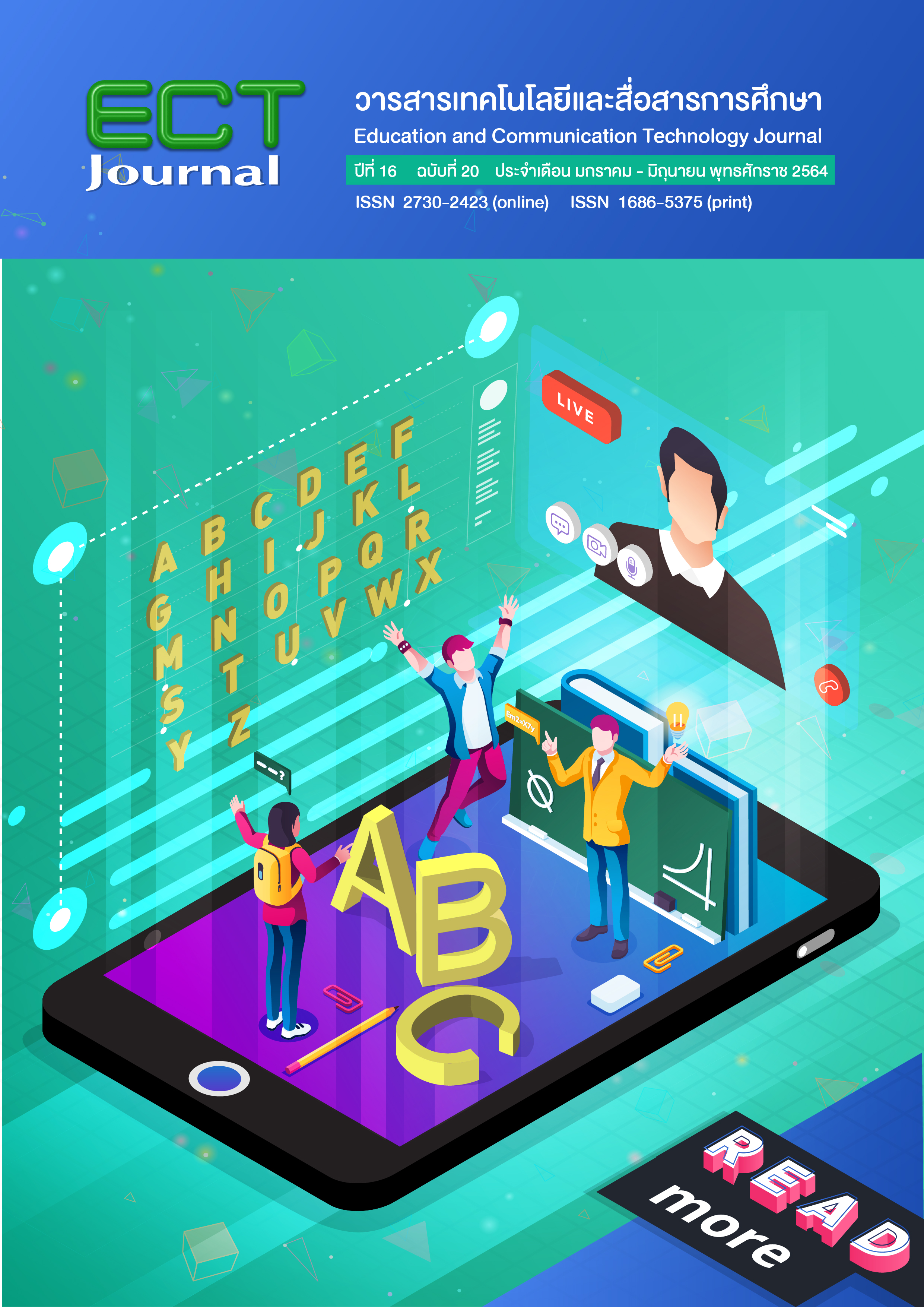Micro-learning Design of the Digital Age
Keywords:
Micro-learning, Micro-learning Design, Digital AgeAbstract
Micro-learning, a digital media that deliver the learning content to learners through the learning activity in term of “Micro” or gradually learning in learning environment. Micro-learning can be used with daily activities of learners using “push” technology and mobile equipment of learners. The instructional design is under the concept “Less is More”; adequate content but more learning which help learners to self–directed learning. The learning objectives of micro-learning is specific to promote long term learning of modern instructional management under the efficient tiny learning environment. This article is to construct the knowledge and understanding of micro-learning on fundamental, theory, design, and trend of micro-learning, including the research findings that reflex the new concept to apply the real situation of learning management in digital age.
References
ธารีย์ณิชา ลีพีรวิทิต, กว้าน สีตะธนี, และวิเชียร ชุติมาสกุล. (2560). การเพิ่มประสิทธิผลการเรียนรู้ของเจนเนอเรชันแซดผ่านการเรียนรู้แบบไมโคร. คณะเทคโนโลยีสารสนเทศ มหาวิทยาลัยเทคโนโลยีพระจอมเกล้าธนบุรี. https://www.sit.kmutt.ac.th/research/article/view/53
ลัดดาวัลย์ คงสมบูรณ์. (2559). การพัฒนาไมโครเลิร์นนิงสำหรับนักศึกษาระดับประกาศนียบัตรวิชาชีพชั้นสูง วิทยาลัยอาชีวศึกษาเอกชนในเขตกรุงเทพมหานคร. วารสารวิชาการมหาวิทยาลัยกรุงเทพธนบุรี, 8(2), 51-62. https://so02.tci-thaijo.org/index.php/bkkthon/article/view/241941
มณฑวรรณ ชัยรัชนีบูลย์. (2020, 8 กันยายน). เทรนด์การศึกษาสมัยใหม่ที่ทุกคนควรติดตามเพื่อเตรียมความพร้อมพัฒนาศักยภาพของนักเรียนนักศึกษาในศตวรรษที่ 21. Disrupt Ignite. https://www.disruptignite.com/blog/school-of-the-future
ศยามน อินสะอาด. (2561). การออกแบบบทเรียนอีเลิร์นนิงเพื่อพัฒนาทักษะการคิดขั้นสูง. ซีเอ็ดยูเคชั่น.
สรลักษณ์ ลีลา, ศศิธร ชูแก้ว, และปรัชญนันท์ นิลสุข. (2562). การพัฒนารูปแบบการจัดการเรียนรู้แบบจุลภาคด้วยหนังสือมีชีวิตเพื่อส่งเสริมการคิดเชิงประมวลผล. ใน การประชุมวิชาการระดับชาติสารสนเทศศาสตร์วิชาการ 2019 (น. 142-151). วิทยาลัยเทคโนโลยีสยาม. https://www.tcp.ac.th/download/สรลักษณ์_ลีลาFinal.pdf
Aitchanov, B., Satabaldiyev, A., & Latuta, K. (2013). Application of micro-learning technique and Twitter for educational purposes. Journal of Physics: Conference Series, 423(1), 12044. https://doi.org/10.1088/1742-6596/423/1/012044
Baumgartner, P. (2013). Educational dimensions of microlearning: Towards a taxonomy for microlearning. In P. A. Bruck & M. Lindner (Eds.), Designing microlearning experiences: Building up knowledge in organisations and companies. Innsbruck University Press. https://www.researchgate.net/publication/305055880_Educational_dimensions_of_microlearning-towards_a_taxonomy_for_microlearning
Emtina, A. (2020). Micro-learning: A pedagogical approach for technology integration. ResearchGate. https://www.researchgate.net/publication/319715909_Micro-learning_A_Pedagogical_Approach_For_Technology_Integration
Hug, T. (2010). Mobile learning as 'microlearning'. ResearchGate. https://www.researchgate.net/publication/291824744_Mobile_Learning_as_'Microlearning'
Merrill, M. D. (2002). First principles of instruction. Educational Technology Research and Development, 50(3), 43-59. https://www.researchgate.net/publication/245682827_First_Principles_of_Instruction
Ray, J. (2006). Rapid instructional design strategies to develop synchronous e-learning. ResearchGate. https://www.researchgate.net/publication/235312031_Rapid_instructional_design_strategies_to_develop_synchronous_e-learning
Shannon, T. (2020, May 29). Micro-learning 101: Using a little learning to grow big skills. iSpring Solutions. https://www.ispringsolutions.com/blog/what-is-micro-learning
Supaporn, C., & Supattra, P. (2020). Designing mangrove ecology self-learning application based on a micro-learning approach. International Journal of Emerging Technologies in Learning, 15(11), 29-41. https://doi.org/10.3991/ijet.v15i11.12865
Wang, Z., Luo, Y., & Qu, Y. (2017). Application of micro-lecture for engineering mechanics experimental teaching. International Journal of Innovation and Research in Educational Sciences, 4(6), 686-689. https://ijires.org/administrator/components/com_jresearch/files/publications/IJIRES_852_FINAL.pdf
Downloads
Published
How to Cite
Issue
Section
License
Copyright (c) 2021 มหาวิทยาลัยสุโขทัยธรรมาธิราช

This work is licensed under a Creative Commons Attribution-NonCommercial-NoDerivatives 4.0 International License.
1. ทรรศนะและข้อคิดเห็นใด ๆ ที่ปรากฏอยู่ในวารสาร ECT Education and Communication Technology Journal เป็นของผู้เขียนโดยเฉพาะ สำนักเทคโนโลยีการศึกษา มหาวิทยาลัยสุโขทัยธรรมาธิราช และกองบรรณาธิการไม่จำเป็นต้องเห็นพ้องด้วย
2. กองบรรณาธิการของสงวนลิขสิทธิ์ในการบรรณาธิการข้อเขียนทุกชิ้น เพื่อความเหมาะสมในการจัดพิมพ์เผยแพร่






